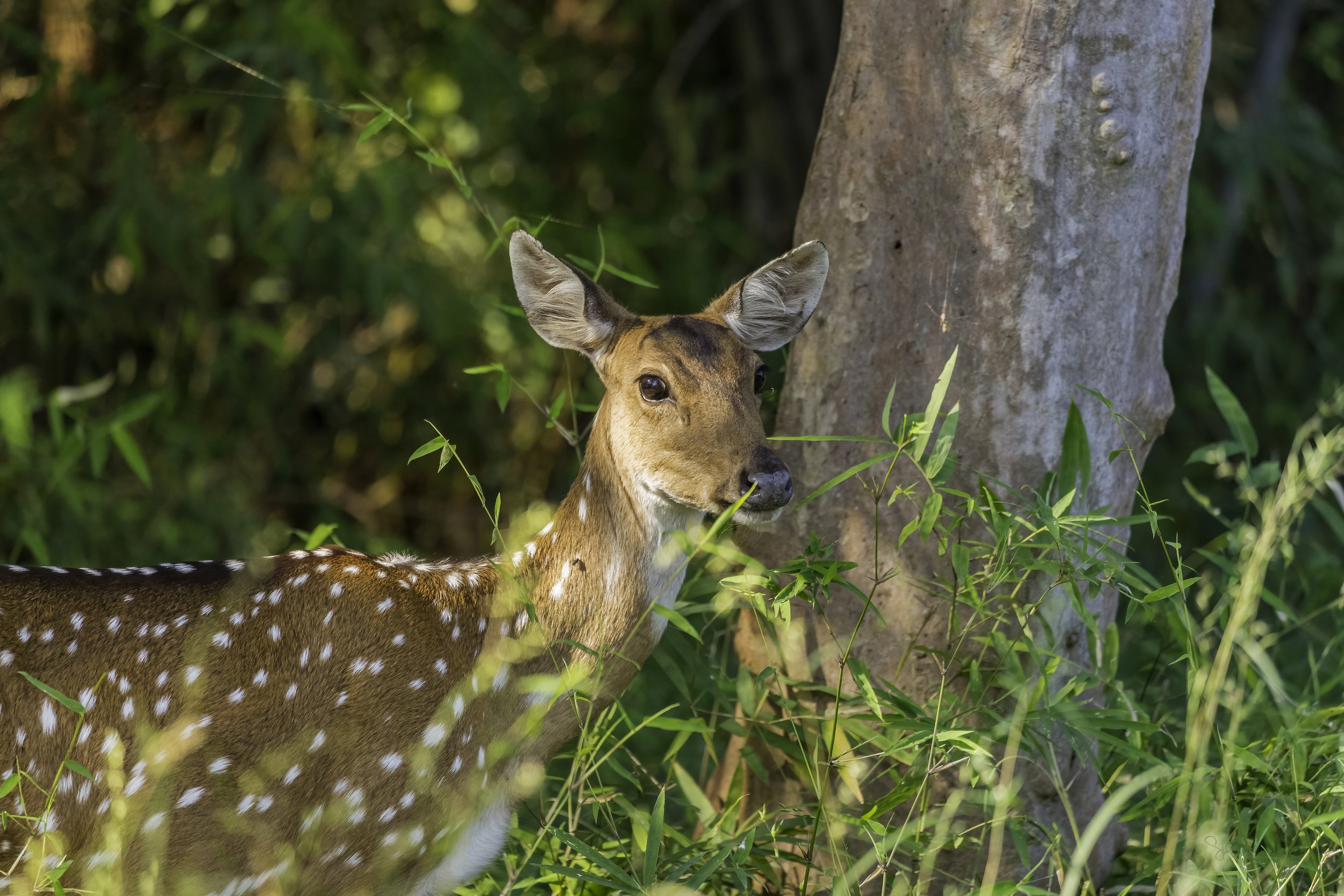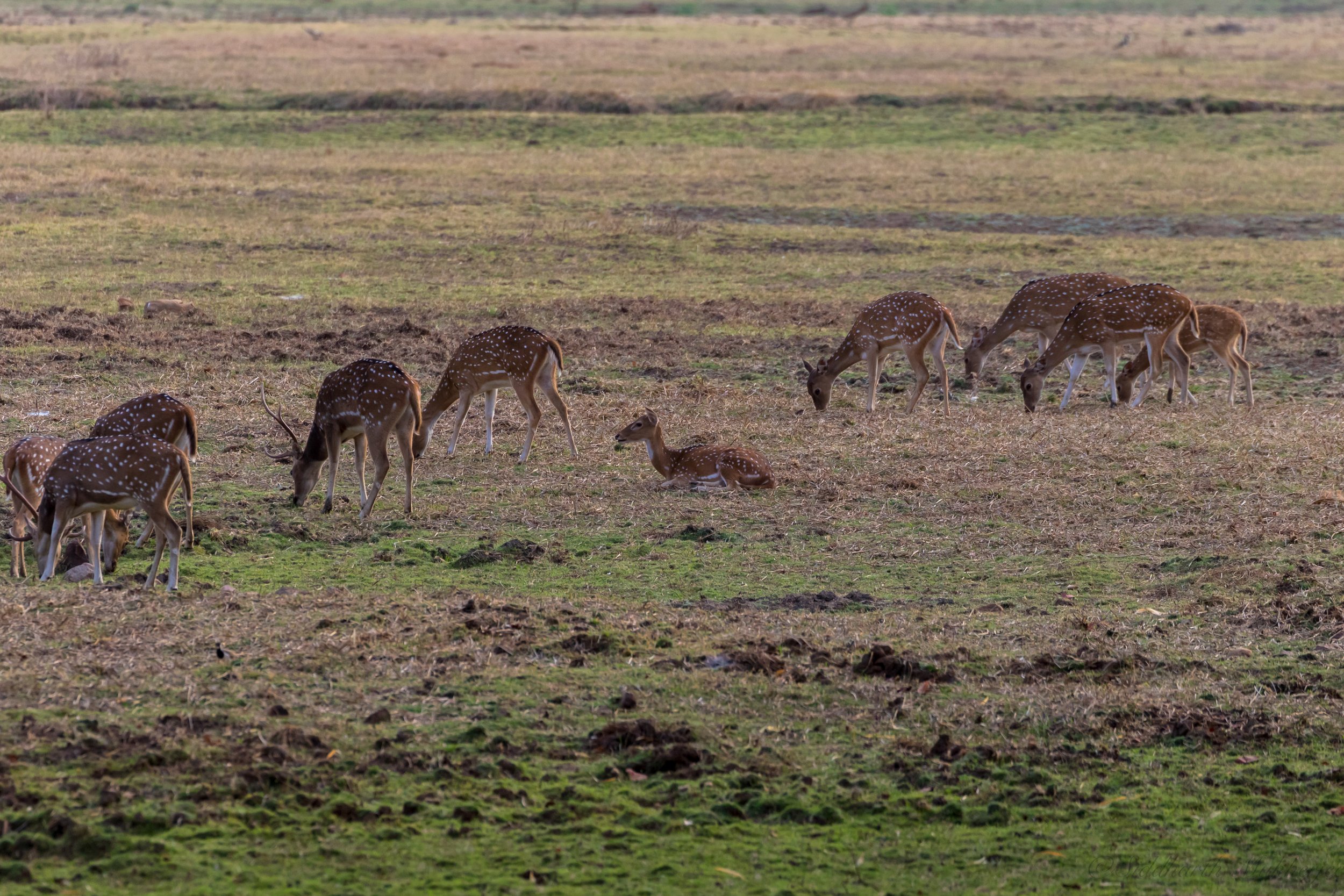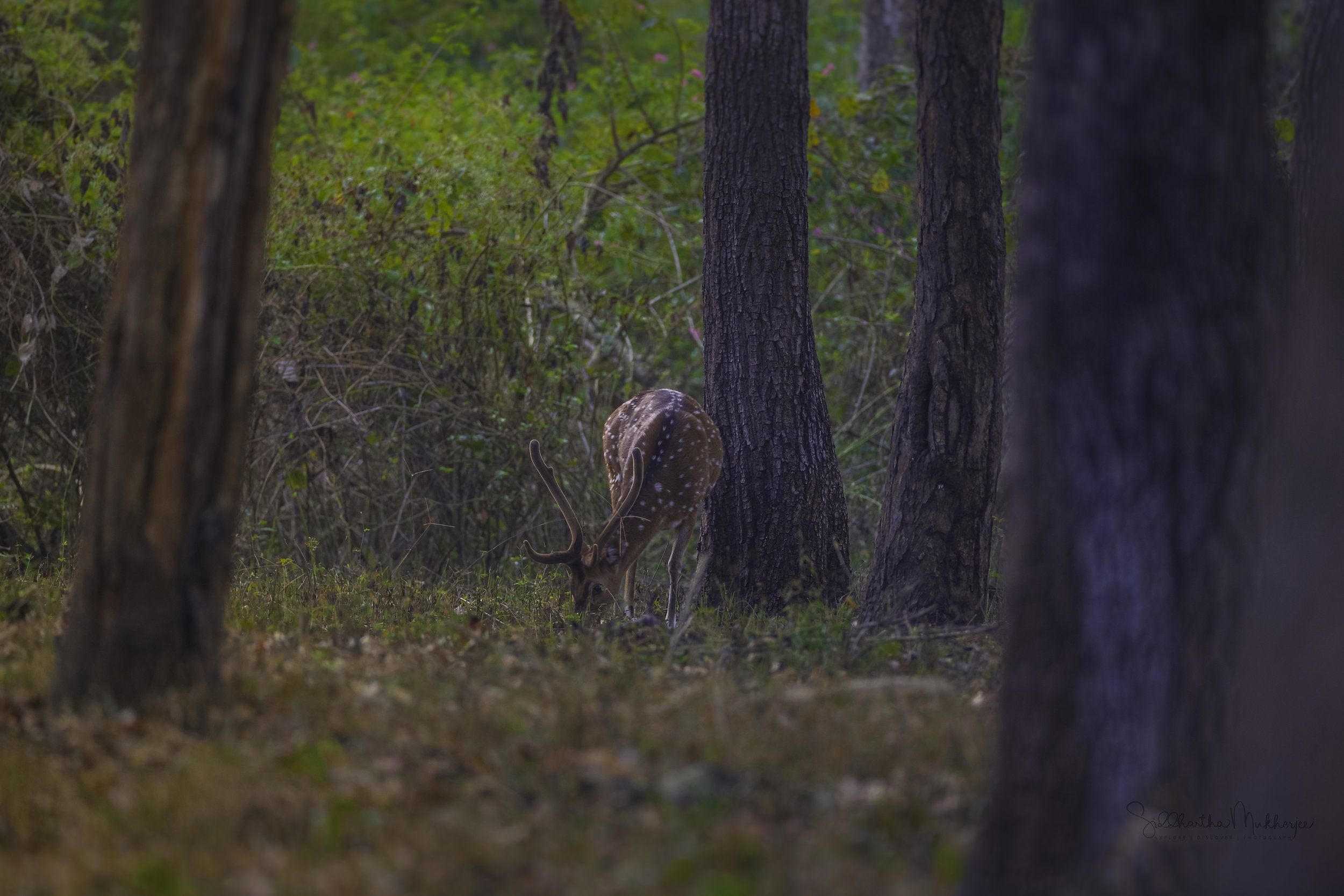Chital
Axis axis
In the wild all over India
My love for the jungles and its inhabitants started when I was about knee high, perched on my grandfathers lap as he taught me jungle lore and narrated the exploits of Jim Corbett. Over the years that love has gradually grown and when my brain needs a refresh, I reach out to the jungle. I first knew the leopard in Rudraprayag from the stories my grandfather narrated as Carpet Sahib tracked and finally brought it down. From then to now I have spent a lot of time traversing the jungles of India and have come across the beautiful wildlife that inhabit these lush forests. Interestingly, the other author from my childhood was the Bangalore based, India-born British hunter & writer, Kenneth Anderson, who combed these very same jungles hunting & photographing wildlife.
“The book of nature has no beginning, as it has no end. Open this book where you will, and at any period of your life, and if you have the desire to acquire knowledge you will find it of intense interest, and no matter how long or how intently you study the pages, your interest will not flag, for in nature there is no finality.”
A photo I’d taken at dusk on the banks of the Kabini River back in July 2008.
In the lush Nilgiri Biosphere, to the south of the famed Nagarhole Tiger Reserve & National Park, on the banks of the river Kasbani lies the area known as Kabini. A major tributary of the Cauvery, the Kasbani is also known as the Kapila river and Kabini River giving the area its name. Consisting mainly of moist deciduous forests, interspersed with teak and eucalyptus plantations, and at a lower altitude compared to Bandipur across the river, Kabini is sprinkled with open grasslands, making it easy to spot wildlife, and providing amazing photographic opportunities.
The erstwhile exclusive hunting grounds of the kings of Mysore, Kabini has lush forests, small rivulets, hills, valleys and waterfalls making it a veritable paradise for many species like the tiger, dhole, gaur, elephants, chital, sambhar and the leopard. One can also spot the critically endangered oriental white-backed vulture, various species of eagles and the Nilgiri wood pigeon.
But I digress - the following photos are of the beautiful Chital who are often seen grazing near trees that house langurs because of two reasons; firstly langurs are able to forewarn them of approaching predators due to their higher position and secondly, langurs often drop fruits that the Chital will feed on.
For more videos: Video Shorts
Chital
The chital or cheetal (Axis axis), also known as the spotted deer, chital deer, and axis deer, is an attractive deer species native to the Indian subcontinent ranging from golden to rufous in colour. They are strongly sexually dimorphic: males are much larger than females and grow large, lyre-shaped antlers. They have white fur on their abdomen, rump, throat, ears and on the inner side of their tails.
The chital were first described and given a binomial name by German naturalist Johann Christian Polycarp Erxlebenin 1777. They are a moderate-sized deer ranging from golden to rufous in colour, male chital reach 90 cm and females 70 cm at the shoulder. While males weigh between 30–75 kg, the lighter females weigh 25–45 kg (55–99 lb). Chital are sexually dimorphic; males are larger than females, and the lyre shaped antlers are present only on the males. The upper parts are golden to rufous, completely covered in white spots. The abdomen, rump, throat, insides of legs, ears, and tail are all white. The antlers, three-pronged, are nearly 1 m or 3 ft 3 inches long.
Our trip to the lush forests of Kabini was dedicated to the search of the famed and elusive Black Panther. We arrived in early January and started on a good note as soon as we entered the forests. Our first contact was with the Tiger Tank female (video), one of the ruling tiger families of Kabini. Then we had the good fortune to stumble onto the path of a pack of 7 dhole out on a hunt. We tracked them for almost half an hour recording and photographing.
As we roamed the forests searching for tigers and leopards we saw the abundance of chital and sambar. The vernacular name "chital" comes from cītal (Hindi: चीतल), derived from the Sanskrit word citrala (चित्रल), meaning "variegated" or "spotted". The name of the cheetah has a similar origin. Other common names for the chital are the variation cheetal, Indian spotted deer (or simply the spotted deer) and axis deer.
The dorsal (upper) parts of the chital are golden to rufous, completely covered in white spots. The abdomen, rump, throat, insides of legs, ears, and tail are all white. A conspicuous black stripe runs along the spine (back bone). The chital has well-developed preorbital glands (near the eyes) with stiff hairs. It also has well-developed metatarsal glands and pedal glands located in its hind legs. The preorbital glands, larger in males than in females, are frequently opened in response to certain stimuli.
Each of the antlers has three lines on it. The brow tine (the first division in the antler) is roughly perpendicular to the beam (the central stalk of the antler). The antlers, three-pronged, are nearly 1 m (3 ft 3 in) long. Antlers, as in most other cervids, are shed annually. The antlers emerge as soft tissues (known as velvet antlers) and progressively harden into bony structures (known as hard antlers), following mineralisation and blockage of blood vessels in the tissue, from the tip to the base. A study of the mineral composition of the antlers of captive barasinga, chital, and hog deer showed that the antlers of the deer are very similar.
Chital - Range & Distribution
Hooves measure between 4.1 and 6.1 cm (1.6 and 2.4 in) in length; hooves of the fore legs are longer than those of the hind legs. The toes taper to a point. The dental formula is same as that of the elk. Compared to the hog deer, the chital has a more cursorial build. The antlers and brow tines are longer than those in the hog deer. The pedicles (the bony cores from which antlers arise) are shorter, and the auditory bullae are smaller in the chital. The chital may be confused with the fallow deer. Chital have several white spots, whereas fallow deer usually have white splotches. Fallow also have palmate antlers whereas chital have 3 distinct points on each side. The chital has a prominent white patch on its throat, while the throat of the fallow deer is completely white. The biggest distinction is the dark brown stripe running down the chital's back. The hairs are smooth and flexible.
The chital ranges over 8–30°N in India and through Nepal, Bhutan, Bangladesh, and Sri Lanka. The western limit of its range is eastern Rajasthan and Gujarat. The northern limit is along the Terai belt of the foothills of the Himalaya and from Uttar Pradesh and Uttaranchal through to Nepal, northern West Bengal and Sikkim and then to western Assam and the forested valleys of Bhutan, which are below an elevation of 1,100 m (3,600 ft). The eastern limit of its range is through western Assam to the Sunderbans of West Bengal and Bangladesh. Andaman and Nicobar Islands and Sri Lanka are the southern limits. Chital occur sporadically in the forested areas throughout the rest of the Indian peninsula. Within Bangladesh, it currently only exists in the Sundarbans and some ecoparks situated around the Bay of Bengal, as it became extinct in the central and north-east of the country.
Chital are active throughout the day. In the summer, time is spent in rest under shade, and the sun's glare is avoided if the temperature reaches 80 °F (27 °C); activity peaks as dusk approaches. As days grow cooler, foraging begins before sunrise and peaks by early morning. Activity slows down during midday, when the animals rest or loiter about slowly. Foraging recommences by late afternoon and continues till midnight. They fall asleep a few hours before sunrise, typically in the forest which is cooler than the glades. These deer typically move in a single file on specific tracks, with a distance of two to three times their width between them, when on a journey, typically in search of food and water sources. A study in the Gir National Park (Gujarat, India) showed that chital travel the most in summer of all seasons.
A herd of chital through the early morning fog at Pench National Park
Chital and Gaur grazing together at Tadoba Andhari National Park
Chital form small matriarchal herds comprising an adult female with her offspring of the previous and present year, herds of male bachelors and breeding herds of females with juveniles. Breeding occurs throughout the year, with peaks after the rutting season which varies geographically. Males with hard antlers are dominant over those in velvet or without antlers, and engage in a variety of mating displays, including rearing up and thrashing vegetation with forelegs, rubbing or hitting antlers on bushes, giving coarse bellows and sparring. When cautiously inspecting its vicinity, the chital stands motionless and listens with rapt attention, facing the potential danger, if any. This stance may be adopted by nearby individuals, as well. As an antipredator measure, chital flee in groups (unlike the hog deer that disperse on alarm); sprints are often followed by hiding in dense undergrowth. The running chital has its tail raised, exposing the white underparts. The chital can leap and clear fences as high as 1.5 m (4.9 ft) but prefers to dive under them. It stays within 300 m (980 ft) of cover.
A vocal animal, the chital, akin to the North American elk, gives out bellows and alarm barks. Its calls are, however, not as strong as those of elk or red deer; they are mainly coarse bellows or loud growls. Bellowing coincides with rutting. Dominant males guarding females in oestrus make high-pitched growls at less powerful males. Males may moan during aggressive displays or while resting. Chital, mainly females and juveniles, bark persistently when alarmed or if they encounter a predator. Fawns in search of their mother often squeal. Chital often occur in the company of Common Myna, Sambar and Grey Langurs. and can respond to their alarm calls. They have a commensual relationship with the Common Myna, a common bird belonging to the starling family, who benefit from the insects disturbed by browsing deer. The relationship with Sambar and Grey Langurs is more mutualistic, as both species benefit from the extra vigilance of larger numbers and will both react to alarm calls of the other species. From their high vantage points, Grey Langurs make good sentinels, and chital also benefit from food dropped or dislodged by the foraging monkeys.
Chital feed on both grasses and shrubs, which mean they find plenty of suitable habitats in their native countries of Bangladesh, Bhutan, India, Nepal and Sri Lanka. They were also historically introduced to Australia, Hawaii and Croatia, where they can still be found today.
Although they are hunted in many areas for their meat, they are not subject to conservation concern as they are common over a wide range of habitats. However, they are an important prey species for several Endangered predators including Bengal Tigers, Leopards, Dhole, and Asiatic Lions.
I have been fortunate to witness many wild animals in their natural habitat in all their glory and these encounters with the Chital are among my favourite experiences as they have provided invaluable insights into how they coexist and leverage other species to stay safe from the apex predators of these Indian jungles.
With that let’s move onto the photos of the graceful chital.
‡‡‡‡‡
Related Posts
















